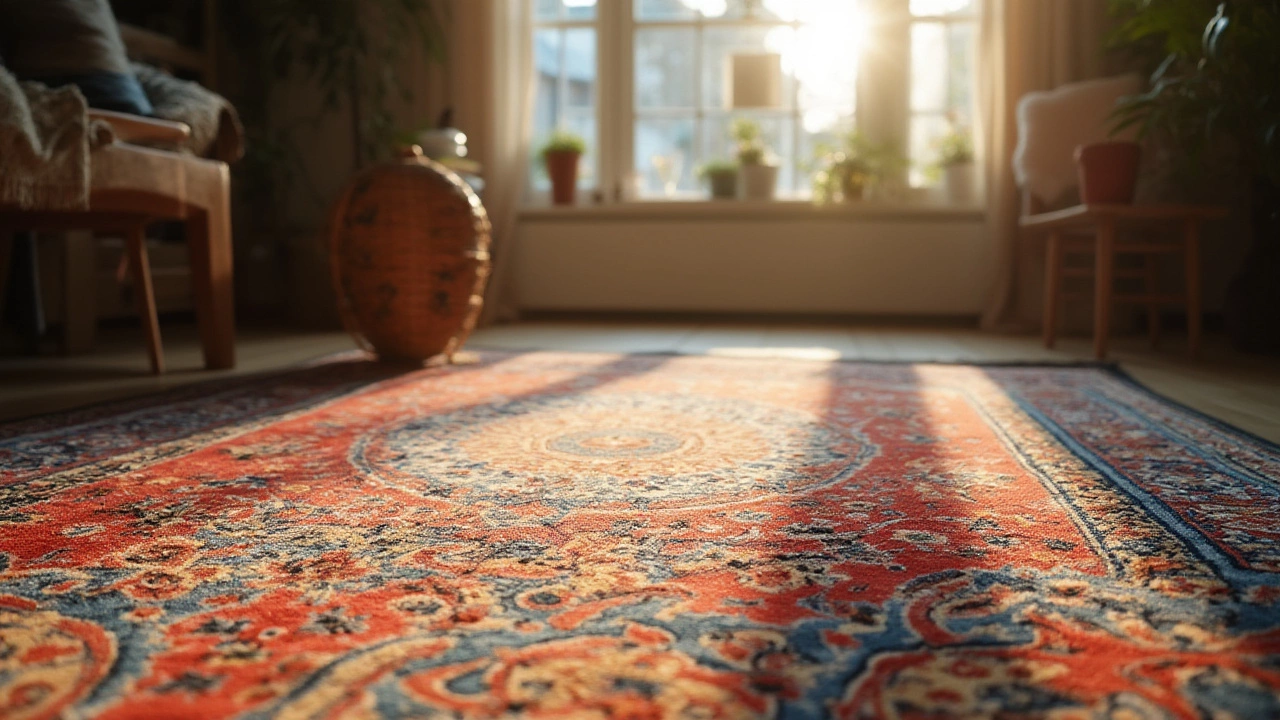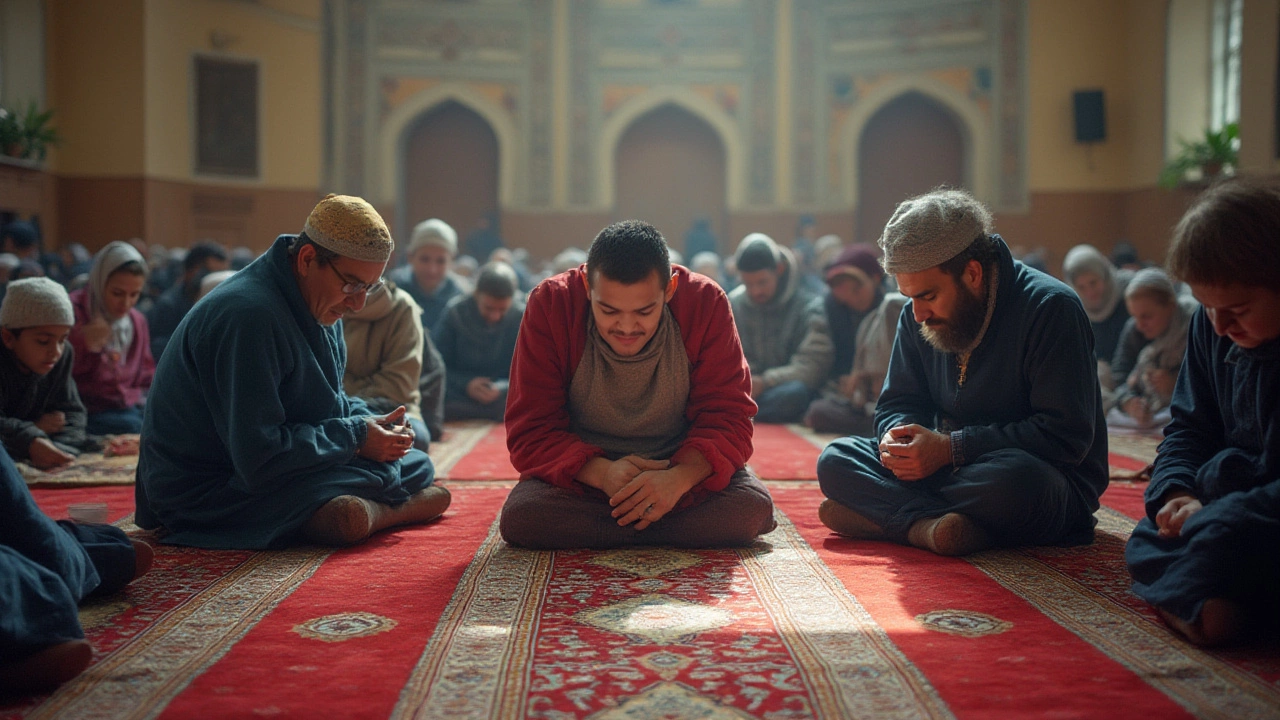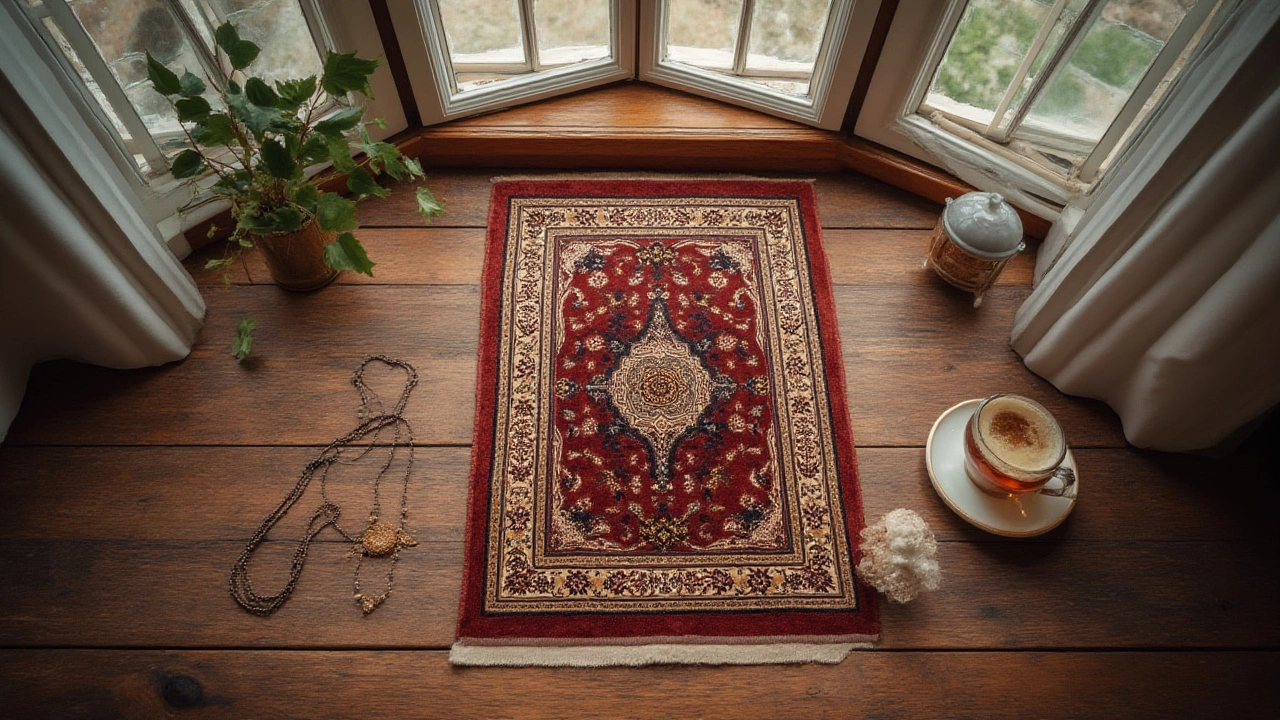What Do Muslims Call the Rug? Prayer Rug Uses, History & Symbolism
 Jul, 27 2025
Jul, 27 2025
If you’ve ever caught a glimpse of those beautifully patterned small rugs tucked under the arm of someone on their way to a mosque, or maybe you’ve scrolled past a post of one laid out in a quiet corner with soft sunlight spilling over it, you might have wondered: What do Muslims actually call those rugs? Is it just a rug for the floor, or does it carry a bigger meaning? Turns out, it’s not just about décor—it’s about something deeper, rooted in daily rituals and a centuries-old culture. This article uncovers what these rugs are called, why they matter, and why you’ll find them basically everywhere Muslims pray, from living rooms in Malaysia to bus stations in Istanbul.
What Is the Muslim Prayer Rug Called?
Let’s get straight to the point: the special rug Muslims use for prayer is commonly called a "prayer rug" in English. But ask any Arabic speaker, and you’ll probably hear the word "sajjada" (سجادة). In Turkish, it’s called "seccade;" in Persian, "janamaz;" and in Urdu, also "janamaz." Despite the language, the meaning is the same—a rug or mat used specifically for praying.
Here’s the thing: Muslims pray five times a day in a ritual called "salah" (or "salat"). Cleanliness is a big deal when it comes to prayers. That’s where the prayer rug comes in. It’s not just a piece of fabric to kneel on; it’s basically a personal, portable sanctuary. The surface is kept clean, which means you’re not getting your forehead down on, say, public grass or a dusty tile floor. For many, the sajjada is also a daily reminder to step back from chaos, lay down something special, and connect spiritually.
Wondering how it looks? The classic pattern usually points toward Mecca, the spiritual center for Muslims. There’s often a niche design or a pointed arch called a "mihrab" at one end. That’s actually there to show the way to Mecca—so if you’re traveling and take out your prayer rug, you just need to figure out the direction and lay it down with the mihrab pointing that way. Not all rugs are ultra-colorful or elaborate; some are plain or made from local materials, but they all serve the same purpose.
This tradition goes back to the earliest days of Islam in the seventh century. The first Muslims prayed on natural ground or mats made from palm fronds, but as cities grew and people moved around, portable rugs became the norm. By the medieval period, especially in Persia and the Ottoman Empire, prayer rugs started featuring lush designs—flowers, geometric patterns, even images of mosques.
Here’s a fun fact for the design lovers out there: the creation of prayer rugs actually helped fuel the development of the rug-weaving arts in regions from Morocco to India. These rugs could range from rough and simple to wildly intricate and expensive, some taking months to weave by hand. They’re sort of like a little snapshot of the art, taste, and beliefs of each time and place. Today, you’ll find sajjada made with synthetic fibers and bold digital prints, as well as antique silk ones that sell for thousands at auction.
So next time you see the word "sajjada," know that it’s more than just a floor covering. It’s a combination of faith, history, and identity packed into something you can roll up and carry. And yes—if you’re interested—there are even travel-sized versions, waterproof versions for outdoor use, and plush ones for comfort on hard flooring. It’s all about making prayer possible, wherever life takes you.

Symbolism, Custom, and Everyday Use of the Sajjada
Okay, so now that you know the name, let’s talk about what this rug really represents for everyday Muslims. It’s not just a box on a checklist. Each time someone spreads out their sajjada, there’s a ritual to it. First, you make sure your place and your rug are clean. For many people, the act of rolling out their prayer rug is almost like flipping a mental switch—the start of a few minutes of calm and focus.
The mihrab design isn’t just for aesthetics; it becomes the spiritual doorway facing Mecca. You’ll notice people often treat their prayer rug with respect—folding it neatly, keeping it off the ground except when actually in use, sometimes even storing it in a special place in the house. In some households, kids learn early how to shake out the rug, lay it down, and make sure it’s pointed the right way. It’s kind of like a family tradition, passed down as much as manners or recipes.
Prayer rugs also blur the line between private and communal. In a mosque, massive carpets cover the entire floor, and individuals find their own spot. At home or in public, spreading your own makeshift "sacred space" is a way to turn basically anywhere—a hotel room, airport terminal, or city park—into a little patch of peace.
Here’s a quick look at why prayer rugs matter beyond just practicality:
- Personal sanctity: It gives each person a clean, private spot to pray, wherever they are.
- Cultural identity: Designs and weaving styles often tell you where someone is from—from Moroccan diamond shapes to Turkish floral patterns.
- Artistic heritage: They’re often handmade, with families in Turkey, Iran, and Central Asia passing down techniques for generations.
- Social bonding: Sharing a prayer rug or passing down an heirloom rug can mark milestones, like weddings or entering adulthood.
There’s also symbolism woven into the patterns. Some rugs include designs of lamps (representing divine light), trees (a symbol of life), or the Kaaba itself (the cube at the heart of Mecca). Some avoid all imagery, sticking with pure geometry, especially in regions where religious traditions discourage pictures of living things. And while there are strict customs around keeping the rug clean, the practical side is never lost—if you’re praying on rough ground, a thicker rug is a sign of kindness to your knees and forehead.
Prayer rugs are often used by people on the move. A student may roll theirs up in a backpack, a businessperson might keep a small one at the office, and a taxi driver could have one stashed beneath the front seat. During Ramadan or big festivals like Eid, some families bring out special rugs saved just for holidays—fancier patterns, richer colors, sometimes even embroidered with gold or silver thread as a treat.
Want to make sure your prayer rug lasts? Here are some quick tips:
- Clean it regularly, either by gentle handwashing or with a vacuum (for tougher synthetic types).
- Store it in a dry place, rolled or folded flat, to keep the fibers from breaking down.
- Try to avoid stepping on it with shoes, as tradition says the rug should be reserved for clean, bare feet only.
- If you spill something, blot and let dry—don’t rub, which can wear down intricate designs.
Many people like to choose a rug that means something personal. Maybe it’s from a loved one, or maybe you picked it up during a special trip. More and more, people are creating custom designs, blending modern graphics with traditional layouts. Basically, if the rug reminds you to take a breath and focus, you’ve got the right one.
Curious how much time people spend on their prayer rug each day? Observant Muslims pray five times a day. Each prayer might take five to ten minutes. That adds up! If you’re looking for a present for a Muslim friend, a thoughtfully chosen prayer rug, maybe with a pattern from their ancestry or in their favorite color, can be a super meaningful gift.

Prayer Rugs Around the World: Styles, Materials, and Fascinating Trivia
The world of prayer rugs is surprisingly wide. Walk into any bazaar from Morocco to Indonesia, and you’ll be stunned by the sheer variety. Persian rugs with tight knots and subtle symmetry. Turkish rugs with bold reds and blues. Indonesian straw mats woven from coconut or pandanus leaves. Even mass-produced ones from China or Pakistan, stamped with mosque designs and fringe on all sides. The basics stay the same—about as big as a large bath towel, often with a pointed end—but the artistry and materials reflect local tastes and history.
Here’s something not everyone knows: The size of a traditional prayer rug is pretty standard, usually around 70 by 110 centimeters (about 27 by 43 inches), give or take. That’s just enough for one adult to kneel and bow comfortably.
| Country | Local Name | Common Materials | Unique Style Feature |
|---|---|---|---|
| Turkey | Seccade | Cotton, wool, silk | Elaborate floral, geometric patterns |
| Iran | Sajjada | Fine wool, silk | Garden motifs, detailed borders |
| Morocco | Zarbiya | Wool, palm fiber | Berber designs, minimalist shapes |
| India/Pakistan | Janamaz | Cotton, synthetic blends | Bright colors, mosque domes |
| Indonesia | Sajadah | Straw, pandan leaves | Natural fibers, simple weaving |
If you’re out shopping for a prayer rug, you’ll notice the price varies wildly. Handwoven silk rugs can fetch thousands of dollars at auctions in Istanbul or Dubai. Locally produced cotton or synthetic options, though, are made for everyday practicality—they might cost as little as $5 to $10. For many families, it’s the story that matters, not the price. That’s why an old, faded sajjada inherited from a grandparent can be more valuable than a store-bought luxury piece.
Technology’s left its mark, too. These days you can buy digital prayer rugs that play recorded recitations, or ones with built-in compasses to point toward Mecca (so you never have to guess—even in a hotel room in Tokyo). During the pandemic, many people started using their own rugs in mosques and community centers, just to avoid sharing for health reasons. Sales of personal prayer rugs actually spiked in 2020, with some Turkish producers reporting double the orders compared to earlier years.
Here’s a quirky fact: in Central Asia, giant communal prayer rugs—big enough to fit multiple people—are sometimes unfurled during big gatherings, especially during Eid prayers or weddings. These can be several meters long and are often woven as one-of-a-kind family heirlooms.
Ever seen a prayer rug with an odd shape, maybe an extra side or corner? In some Egyptian or Yemeni traditions, there are rugs made for praying in pairs, or for special holidays and funerals. But most often, you’ll see the classic rectangle—that’s what fits one person, head to toe, every day.
One last bit of trivia: the oldest known prayer rug still in existence dates from the 16th century, woven in Ottoman Turkey and now housed in museums. Back then, having a finely woven prayer rug was a sign of wealth and piety—some rulers would even gift them to visiting kings or diplomats as a token of friendship and goodwill.
Want to bring a little bit of this tradition into your own space? You don’t need to be Muslim to appreciate the beauty and craftsmanship. Many collectors hang antique prayer rugs on the wall, frame them under glass, or use them in cozy reading nooks for a dash of color and history. Just remember: if you’re using a Muslim prayer rug, treat it with respect. For many, this isn’t just a rug. It’s a piece of personal sacred ground, wherever you stretch it out.